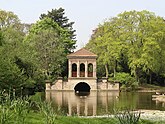
Back Merseyside Afrikaans Merseyside AN مرزيسايد Arabic Merseyside AST Merseyside BAN Мерсісайд Byelorussian Мэрсісайд BE-X-OLD Мърсисайд Bulgarian Merseyside Breton Merseyside Catalan
Merseyside | |
|---|---|
Left to right:
| |
 Location of Merseyside within England | |
| Coordinates: 53°25′N 3°00′W / 53.417°N 3.000°W | |
| Sovereign state | United Kingdom |
| Constituent country | England |
| Region | North West England |
| Established | 1 April 1974 |
| Established by | Local Government Act 1972 |
| Time zone | UTC+0 (GMT) |
| • Summer (DST) | UTC+1 (BST) |
| UK Parliament | 15 MPs |
| Police | Merseyside Police |
| Largest city | Liverpool |
| Ceremonial county | |
| Lord Lieutenant | Mark Blundell |
| High Sheriff | Nigel Lanceley |
| Area | 652 km2 (252 sq mi) |
| • Rank | 43rd of 48 |
| Population (2022)[1] | 1,442,081 |
| • Rank | 9th of 48 |
| Density | 2,211/km2 (5,730/sq mi) |
| Metropolitan county | |
| GSS code | E11000002 |
| Districts | |
 Districts of Merseyside Metropolitan districts | |
| Districts | |
Merseyside (/ˈmɜːrzisaɪd/ MUR-zee-syde) is a ceremonial and metropolitan county in North West England. It borders Lancashire to the north, Greater Manchester to the east, Cheshire to the south, the Welsh county of Flintshire across the Dee Estuary to the southwest, and the Irish Sea to the west. The largest settlement is the city of Liverpool.
The county is highly urbanised, with an area of 249 square miles (645 km2) and a population of 1.42 million.[2] After Liverpool (552,267), the largest settlements are Birkenhead (143,968), St Helens (102,629), and Southport (94,421). For local government purposes the county comprises five metropolitan boroughs: Knowsley, St Helens, Sefton, Wirral, and Liverpool. The borough councils (and Halton in Cheshire) collaborate through the Liverpool City Region combined authority, chaired by an elected mayor.
What is now Merseyside was a largely rural area until the Industrial Revolution, when Liverpool and Birkenhead's positions on the Mersey Estuary enabled them to expand. Liverpool became a major port, heavily involved in the Atlantic slave trade and in supplying cotton to the mills of Lancashire, and Birkenhead developed into a centre for shipbuilding. Innovations during this period included the first inter-city railway, the first publicly-funded civic park, advances in dock technology, and a pioneering elevated electrical railway. The county was established in 1974, before which the entirety of the Wirral was in Cheshire and the remainder of the county was in Lancashire.
Merseyside is notable for its sport, music, and cultural institutions. The Merseybeat genre developed in what is now the county, which has also produced many artists and bands, including the Beatles. The county contains several football clubs, with Everton and Liverpool playing in the Premier League. The Royal Liverpool and Royal Birkdale golf clubs have hosted The Open Championship 22 times between them, and the Grand National is the most valuable jump race in Europe. National Museums Liverpool comprises nine museums and art galleries.
- ^ "Mid-2022 population estimates by Lieutenancy areas (as at 1997) for England and Wales". Office for National Statistics. 24 June 2024. Retrieved 26 June 2024.
- ^ "2009 Mid Year Estimates – Table 9 ONS". statistics.gov.uk. Archived from the original on 16 December 2008. Retrieved 9 September 2010.


